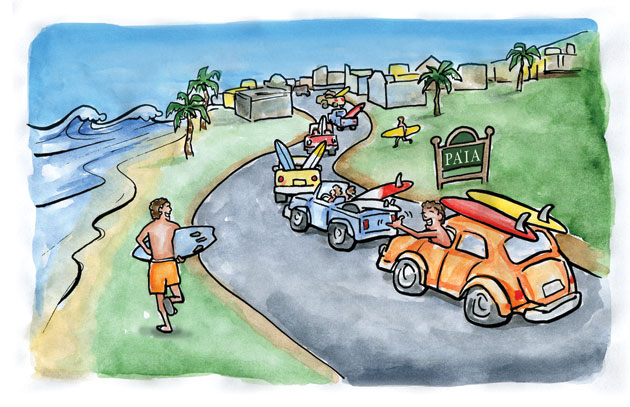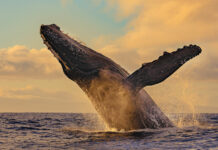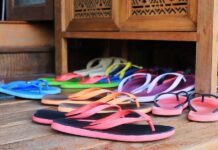Story By Tom Stevens | Illustration by Guy Junker
 In other climes, winter is easy to spot. You just look for snow, ice, sleet, fog, hail, gray skies, bare trees and red noses.
In other climes, winter is easy to spot. You just look for snow, ice, sleet, fog, hail, gray skies, bare trees and red noses.
The season is more elusive here. Except for a little less daylight and a little more rain, winter on Maui is about the same as any other time. Yes, the golden plovers depart, and the humpback whales arrive. And the plumeria trees do drop their leaves. But that’s about it.
Oh, there is one other little difference.
In winter here, you can get swept off the rocks by gigantic surf, pummeled to atoms and sucked out to sea.
Well, not you specifically. You know better. But an unwary person could be victimized in this way. It has happened.
Thus, as a public service to our readers, we offer the following winter surf tips. Feel free to pass them along to any unwary person you may encounter.
First, what are the signs of true monster waves? How can you tell the really big ones from the merely regular ones?
These questions will seem ludicrous to residents of Maui’s windward side, who simply use their senses to register big surf’s arrival. Those who live near shore can hear the surf’s continuous roar, feel its thumping impact, smell and taste its fine salt mist.
Ironically, those who live closest to the waves may not see them best, as really huge surf creates a fog that could cloak a ghost ship. But drive a mile or so uphill, and big surf paints a creamy white margin along the shore. Generally, the bigger the surf, the wider the margin.
Viewers posted above sea level can also gauge the size of a swell by counting the number of “lines” pulsing in from the horizon. During regular surf, you might see one or two waves beyond the wave that’s breaking. On big days, so many lines are visible you can lose count. Surfers call that “corduroy.”
Windward residents use another line to gauge winter-swell magnitude: the line of eastbound traffic stacked up outside Pa‘ia. For instance, ten-foot faces at Ho‘okipa can create a half-mile clog of inching traffic. But if Jaws is going off, eastbound traffic may groan to a halt at Spreckelsville. On those occasions, bring a book. War and Peace.
Finally, savvy surf watchers check the color and consistency of retreating foam to tell when the big ones have arrived. On “normal” surf days, the foam looks white and fizzes away quickly. But on big days, the waves smash so far inland they leach red Maui dirt and other minerals from the shoreline. This discolors the foam and clots it into soapy islands that may last minutes.
Red foam in the morning, surfer take warning.
But what if you’re on Maui’s leeward side? How can you tell huge waves are battering the North Shore if you can’t see them, hear them, smell the salt or feel the mist?
One way is to monitor the frequency of car-wash fundraisers in your area. During spells of epic winter surf, vehicles return from Maui’s windward side as salty as pretzels. More surf equals more community car washes.
Another big-surf indicator is the number of board-topped vehicles streaming in a northeasterly direction. Seasoned surf forecasters also monitor activity levels at isle schools and job sites. Is attendance down? Where are the roofers?
If all else fails, check your car’s windshield. If you see a fine, salty film on the glass, the surf’s up somewhere.





